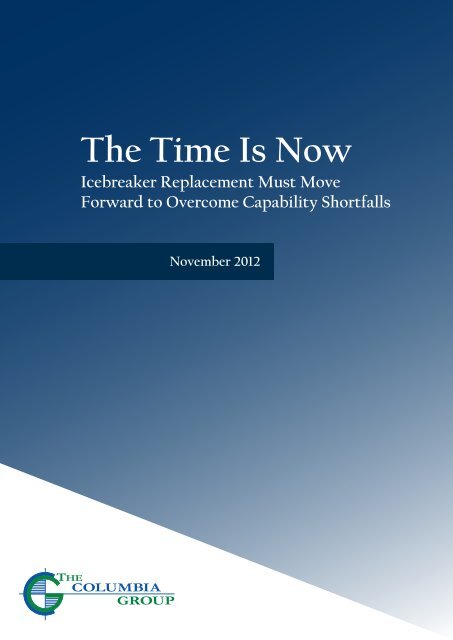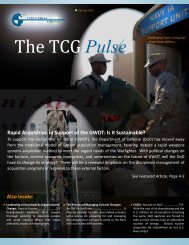Icebreaker Replacement - The Columbia Group
Icebreaker Replacement - The Columbia Group
Icebreaker Replacement - The Columbia Group
You also want an ePaper? Increase the reach of your titles
YUMPU automatically turns print PDFs into web optimized ePapers that Google loves.
<strong>The</strong> Time Is Now<br />
<strong>Icebreaker</strong> <strong>Replacement</strong> Must Move<br />
Forward to Overcome Capability Shortfalls<br />
November 2012
About the Author<br />
Rick Wharton is a retired Coast Guard officer and engineer with 20<br />
years of experience in operation, maintenance and logistics support of<br />
a wide variety of Coast Guard ships and boats, including a tour as the<br />
first Platform Manager for high- and medium-endurance cutters at the<br />
Coast Guard Engineering Logistics Center (now a part of the Surface<br />
Forces Logistics Center). Following his retirement from the USCG<br />
Yard in Baltimore, he supported the Coast Guard Deepwater program<br />
before joining <strong>The</strong> <strong>Columbia</strong> <strong>Group</strong> in 2009. He currently serves as Director<br />
of Operations of <strong>The</strong> <strong>Columbia</strong> <strong>Group</strong>’s Rosenblatt Ship Design<br />
Division.
3<br />
Introduction<br />
January 6, 2012: On the Bering Sea 250<br />
miles south of Nome, Alaska, the Coast<br />
Guard Cutter Healy breaks the ice near<br />
the tanker vessel Renda after it became<br />
stopped in ice, so the Renda could<br />
resume its voyage. (Photo courtesy of<br />
U.S. Coast Guard.)<br />
n this publication, two years ago, a case was made for the increasing need of new polar<br />
Iicebreakers for the U.S. Coast Guard. <strong>The</strong> article concluded that “<strong>The</strong> time has already<br />
passed when the U.S. should have started the long process of acquiring two new vessels to<br />
replace the Polar Class.” This echoed the 2007 conclusion by the National Research Council<br />
that the United States should “immediately” begin the design and construction of two new<br />
polar icebreakers, and the later 2008 statement by then Coast Guard Commandant Admiral<br />
Thad Allen that the Coast Guard was “at a crisis point” on a decision to build new icebreakers.<br />
Since that time, ongoing disagreement between congressional appropriators and the<br />
Obama Administration over the best course to maintain the nation’s icebreaking capability<br />
has led to continuing delays in funding any new acquisition program to begin the replacement<br />
of the polar icebreakers.<br />
Over the last two years, several developments have occurred that reinforce the urgency for<br />
the U.S. Coast Guard to maintain or even expand their capabilities in the Arctic. Most significantly,<br />
the area of the arctic that remains ice-covered has continued to decrease steadily,<br />
with 2012 set to be the smallest percentage of ice coverage since 1979 when records began.<br />
(See Figure 1 on next page.) With increased access to artic waters comes a corresponding<br />
increase in activity for shipping, resource exploration / extraction, and tourism. <strong>The</strong> most<br />
visible sign of this phenomenon over the past several months has been Shell’s efforts to<br />
develop exploratory wells in areas that were previously largely ice-covered. While technical<br />
challenges and an abundance of caution prevented the completion of these wells this year,<br />
efforts will continue next season to establish these wells and begin tapping the oil and gas<br />
resources beneath the Beaufort and Chukchi seas.<br />
Despite this activity increase, the only two heavy icebreakers in the U. S. inventory, the Polar<br />
Star and the Polar Sea, remain non-operational. Other than a privately-owned medium<br />
icebreaker leased by the National Science Foundation, the USCGC Healy (WAGB – 20) remains<br />
the only operational U.S. <strong>Icebreaker</strong>. While the Healy possesses significant capability<br />
to support scientific research, unlike the Polar Star and Polar Sea, Healy is not capable of<br />
heavy icebreaking as is required, for example, for break-in and resupply of McMurdo station<br />
in Antarctica. Instead, recent heavy icebreaking requirements have been met by leasing foreign<br />
icebreakers from Sweden or Russia. Some of the limitations of the Healy were demonstrated<br />
during the January 2012 break-in to Nome to deliver fuel oil in conjunction with an<br />
ice-capable Russian oil tanker. While the mission was ultimately successful, the day-by-day<br />
concerns over whether Healy would be able to continue would not have been an issue had a<br />
heavy icebreaker been available.<br />
Capability Gaps<br />
In 2011, the Coast Guard provided to Congress the “High Latitude Study Mission Analysis<br />
Report.” This report presented a broad look not just at icebreaking, but at all Coast Guard<br />
missions in the Polar Regions. <strong>The</strong> study identified capability gaps (inabilities to fully<br />
perform the mission) in the Coast Guard’s performance of most of its statutory missions in<br />
the Arctic and Antarctic. <strong>The</strong> most significant shortcomings were in the areas of: Defense<br />
Readiness; Ice Operations; Marine Environmental Protection; and Ports, Waterways<br />
and Coastal Security. <strong>The</strong> study concluded that to meet its statutory missions, the<br />
Coast Guard needed three heavy and three medium icebreakers. Further, if the Coast
4<br />
Guard was to meet its statutory missions, and maintain a continuous presence in the Polar<br />
Regions in support of the 2010 Naval Operations Concept, it would require six heavy and<br />
four medium icebreakers. This could be reduced to four heavy and two medium icebreakers<br />
through multiple crewing and strategic homeporting.<br />
Figure 1: Artic Sea Ice Extent 2007-2012, area of the ocean with at least 15% sea<br />
ice. From the National Snow and Ice Data Center.<br />
In the summer of 2012, the Coast Guard began Arctic<br />
Shield 2012, a four-month exercise designed to evaluate<br />
the service’s ability to carry out its statutory missions<br />
in the arctic using high- and medium-endurance<br />
cutters (WHEC, WMEC), buoy tenders (WLB),<br />
fixed- and rotary-wing aircraft, and an interconnecting<br />
C4ISR network. <strong>The</strong> exercise includes maritime safety<br />
and security, pollution response, outreach to indigenous<br />
communities, and joint operations with NORTH-<br />
COM. While the exercise represents a significant step<br />
in a coordinated approach to arctic domain awareness,<br />
it has some significant limitations. WHECs and<br />
WMECs are not ice-strengthened and cannot operate<br />
safely in areas where even free-floating ice may be encountered.<br />
WLBs are capable of light icebreaking, but<br />
being designed for only 21 days underway endurance<br />
they are not capable of long patrols far from their bases<br />
in southern Alaska. Ice-capable cruise ships and icestrengthened<br />
drilling platforms such as Shell’s Sakhalin<br />
2, which enable operation in arctic areas throughout<br />
much of the year, will mean increased activity during<br />
periods when only an icebreaker can provide the onscene<br />
presence necessary for the Coast Guard to carry<br />
out its missions.<br />
Territorial Claims<br />
As the arctic ice recedes and additional areas of the Arctic Ocean and surrounding seas are<br />
navigable throughout a greater part of the year, territorial claims in the region have become<br />
an increasingly high-profile discussion. Five nations border the arctic, including the U.S.,<br />
Denmark (via Greenland), and Norway, with Canada and Russia having the greatest Arctic<br />
coastlines. Under the United Nations Convention on the Law of the Sea (UNCLOS), ratifying<br />
countries may assert claims for exclusive rights to resources on and below the seabed of<br />
their extended continental shelves. This often extends well beyond the 200-mile exclusive<br />
economic zone. When the area surrounding the Arctic Ocean was ice-covered all or most of<br />
the year, it was impractical to recover the resources on the extended continental shelf. With<br />
larger areas ice-free for longer periods of time, these territorial claims have taken on a greater<br />
importance. Canada, Russia, Norway and Denmark have all taken steps to establish claims<br />
on the arctic continental shelf.<br />
In August 2012, the icebreaker Xuelong (Snow Dragon) made the first passage by a Chinese<br />
ship of the arctic Northern Sea Route. While China has no territorial claims in the arctic,<br />
this heightened interest in arctic exploration by one more industrialized nation further illustrates<br />
the need for the U.S. to be capable of maintaining an extended presence in the region.<br />
Leasing of one or more heavy icebreakers has been advocated in various forums as a potential<br />
stop-gap measure to meet the immediate U.S. need. Maintaining a national presence is one<br />
mission where this may not be a viable alternative. In August, Coast Guard Commandant<br />
ADM Robert Papp acknowledged that the Coast Guard has looked at the business case for
5<br />
leased icebreakers as a short-term solution, but there are legal uncertainties associated with<br />
law enforcement and defense operations involving a ship that is not a sovereign military<br />
vessel.<br />
Aerial view of Shell’s platform at Sakhalin<br />
2 in Russia’s far east.<br />
Increased Arctic Tourism<br />
Increasing availability of open water has also brought an increase in tourism to the arctic.<br />
Some of this increase preceded the most significant reductions in sea ice, and instead<br />
resulted from the prevalence of ice-strengthened cruise ships being built to meet increasing<br />
demand for recreational access to the arctic. In 2006 alone, the number of arctic cruise<br />
ships operating out of Canada doubled from 11 to 22. A natural consequence of this kind<br />
of growth in the number of cruise ships in the arctic is a similar increase in emergency<br />
incidents, to which the Coast Guard may be expected to respond. In the 18 years between<br />
1972 and 2000, there were 11 reported groundings of cruise ships in the arctic region. From<br />
2000 to 2009 – nine years – there were 16 reported groundings, an increase of nearly 300%<br />
per year. With more arctic ports accessible for greater periods of time, these figures can<br />
logically be expected to continue to increase. Unlike many popular cruise destinations such<br />
as the Caribbean, distances in the arctic make it difficult for land-based rotary-wing aircraft<br />
to reach many of the areas where assistance may be required, so the presence of a platform<br />
such as a helicopter-equipped ice-capable ship can be essential to a timely response to an<br />
emergency.<br />
No Quick Solution<br />
<strong>The</strong> Polar Star (WAGB-10) is currently undergoing a four-year major renovation and is<br />
scheduled to re-enter service in 2013. Even following the renovation, its service life is only<br />
expected to be extended to 2020. <strong>The</strong> Polar Sea (WAGB-11) has been in caretaker status<br />
(i.e. non-operating condition with limited preservation) since 2010, and was going to be cannibalized<br />
for parts and then scrapped until recent legislation stipulated that it be retained at<br />
least until a strategy for replacement is established. With no current program for replacement<br />
of the heavy icebreakers underway, it is already very late to begin the process for<br />
acquisition of new polar icebreakers with the expectation of having an operational ship to<br />
replace the Polar Star in 2020.<br />
Further complicating the long timeline for acquisition is the fact that no existing U.S. shipyard<br />
has built a heavy icebreaker. Specialized capabilities for forming and joining the highstrength<br />
cold-resistant steel required for an icebreaker hull would need to be introduced and<br />
developed before a U.S. yard could undertake the construction. Several European countries,<br />
notably Finland, have well-established yards building icebreakers for other countries including<br />
Russia, which has its own icebreaker-capable yards as well. One solution to reduce the<br />
learning curve for U.S. builders might be to purchase an icebreaker hull built in Europe and<br />
complete the outfitting at a yard in the U.S..<br />
Another possible way to increase the Coast Guard’s arctic capabilities would be to construct<br />
an ice-strengthened variant of the Offshore Patrol Cutter (OPC), which is programmatically<br />
several years ahead of any possible new icebreaker. While it would not be capable<br />
of heavy icebreaking, it could operate in open water in the vicinity of ice where current<br />
high endurance cutters (WHECs) and medium endurance cutters (WMECs) cannot. <strong>The</strong><br />
OPC request for proposal has recently been released with no requirements for ice capability.<br />
Even so, introducing requirements for an ice-capable variant early in the program, say<br />
after the second or third hull, would likely still be several years ahead of a new icebreaker<br />
acquired from the ground up. No matter the approach it is critical that the U.S. Coast Guard<br />
receive the support it requires now to begin acquiring new polar ice breakers so that it can<br />
meet its mission to “protect the public, the environment, and U.S. economic interests […] in<br />
any maritime region as required to support national security” including the arctic.










![[x] amendment of solicitation/modification of contract - The Columbia ...](https://img.yumpu.com/26856860/1/190x245/x-amendment-of-solicitation-modification-of-contract-the-columbia-.jpg?quality=85)





